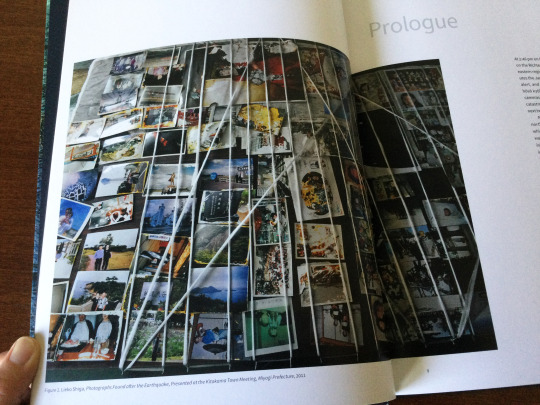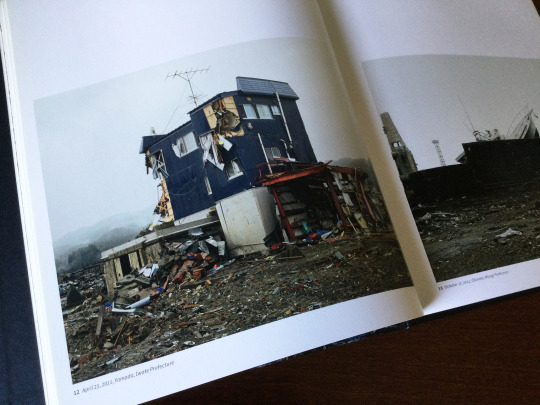#Leiko Shiga
Explore tagged Tumblr posts
Text
Week 8 - Shiga Lieko - Rasen Kaigan (Spiral Shore)
Shiga Leiko has documented the village of Kitakama which was devastated by the 2011 tsunami that hit there. She used her photographs to convey the spirit and history that was found within the community there. She said she tried to use photos to convey something we could not see with the naked eye. The spirit and history, the things that brought the community together.
As someone looking at places and their history, though with a paranormal twist. I find her work really inspiring to look at places and try to see and then portray the unseen. The way she interacted with the locals and tried to tell their stories and history within her photos. I like how each photo has its own story to tell that all relate to the overall theme of the history of the village.
I like how all her photos feel like they have a similar mood and tone of light. Most are dark and then have an area of harsh light highlighting the figure or object/place. It accentuates the featured subject as well as creates a feeling of capturing the time of those who where once there.
In her photo book, she mainly focuses on whole-page spreads but also has a decent amount of double-paged spreads as well. Which she has made sure to correlate with each other.





Photos screenshotted from:
youtube
RASEN KAIGAN - Lieko SHIGA | shashasha - Photography & art in books
0 notes
Photo




Today marks ten years since the March 2011 Tohoku Earthquake of magnitude 9.0 and subsequent tsunami. The powerful tsunami caused meltdowns of reactors at the Fukushima Daiichi Nuclear Power Plant. It was the most powerful earthquake ever recorded in Japan with catastrophic casualties, including 15,899 deaths, 6,157 injured, and 2,529 missing. Years later, approximately three thousand extra deaths have been confirmed as earthquake-related, bringing the total number of deaths to 19,575. (Information taken from Wikipedia.)
“Since March 11, 2011, disasters both natural and man-made have continued to happen around the world. The great fear of many who experienced the Great East Japan Earthquake and its aftermath is that these catastrophes will fade from memory. In Tohoku the endless mounds of twisted metal have been cleared away, and most of the landmarks of destruction made famous by news coverage have been dismantled. Yet recovery from the tsunami is far from complete, and the ongoing nuclear cleanup in Fukushima continues to affect not only personal lives but political developments. The photographs presented here ensure that what happened on that day will not be forgotten, while the power of their imagery invites us to contemplate, question, and yes, find profound beauty.” – (from Prologue, Anne Nishimura Morse and Anne E. Havinga, p.15.)
Unfortunately, on February 13, 2021, Fukushima experienced yet another powerful earthquake of magnitude over 7.0, resulting in nearly 200 people injured and more than 950,000 homes without power.
“In the wake : Japanese photographers respond to 3-11” was published in conjunction with an exhibition held at the Museum of Fine Arts, Boston, April 5 - July 12, 2015.
Image 1: Front cover, “Rasen Kaigan (Spiral Shore), 46, 2011, detail, by Leiko Shiga Image 2: “Photographs Found after the Earthquake, Presented at the Kitakama Town Meeting, Miyogi Prefecture, 2011” by Leiko Shiga Image 3: “April 25, 2011, Yamada, Iwate Prefecture” by Keizo Kitajima Image 4: From the series, “Site/Cloud” 2012-2013 by Daisuke Yokota
In the wake : Japanese photographers respond to 3-11 Attribution: Anne Nishimura Morse and Anne E. Havinga ; with contributions by Michio Hayashi, Marilyn Ivy, and Tomoko Nagakura. 1st edition. Boston : MFA Publications, [2015] New York : ARTBOOK/D.A.P. 207 pages : illustrations (some color) ; 33 cm English Museum of Fine Arts, Boston [host institution] ISBN : 9780878468270 ISBN : 0878468277 HOLLIS number: 990143807030203941
#tohokudaishinsai#tohokuearthquake#fukushima#earthquake#tsunami#東北大震災#東北大震災10年#福島#日本の写真家#japanesephotographer#japanesecontemporaryphotography#photography#harvardfineartslibrary#harvardfineartslib#fineartslibrary#Harvard#harvard library#HarvardLibrary
16 notes
·
View notes
Photo

Leiko Shiga, 349243. 2012
3 notes
·
View notes
Text
Fault Line, by Sophie Barbasch
About
I started studying photography in high school and then got more serious about it during college. After college, I realized I wanted to pursue my MFA. Grad school helped me a lot in terms of understanding what I was trying to do and say with my work. I feel like I am still processing some of the feedback I got, even though I’ve been out of school for a number of years now. I have experimented with other media, but I feel like photography comes closest to expressing how I experience the world. Even so, I still think a lot about what images cannot express and how to fill those gaps.
Preferences, preparations, photography equipment
It depends a lot on the project—sometimes, I stage the images and work with a tripod. For other projects, I just shoot hand-held and respond in the moment. I am using the Mamiya 7 and the Sony mirrorless camera right now. I love film, but digital is very liberating.
Project statement
Artist Statement: Fault Line
Fault Line is a story about my family. The protagonist is my younger cousin Adam. It takes place in Brooklin, Maine, where he lives. I have been working on this project intensively since 2013.
It was then that I went to visit Adam and was overwhelmed by his intelligence, humor, and vulnerability. I couldn’t help but feel connected to him. We understood each other in a way no one else in the family did. I felt like he was my stand-in, my double. When we started taking pictures, we both wanted to make the same images; I didn’t have to explain anything.
In 2013, I had already been estranged from my father for seven years. I wanted to return to a family base to understand what had happened. I wanted to make images that expressed moments from the past: moments of conflict, isolation, and despair. I also wanted to express the desire to connect to family and to belong to something. I chose the surreal landscape of Brooklin, sandwiched between the coast and the dense forest, to begin exploring these fragments from my childhood. I used Adam as my model. Over the years, I also began to incorporate myself, my brother, my aunt, my cousins, and finally my father, into the images.
Influences and favorite stuff within and outside of photography
At the moment, I am inspired by the Not Surprised project (http://www.not-surprised.org/) as well as Barbara Kruger’s new NYC Metrocard series. I just finished reading The Babysitter at Rest by Jen George, which I loved. My new favorite photo book is Blind Date by Leiko Shiga.
Instagram Website
Copyrights: All the pictures in this post are copyrighted Sophie Barbasch
Fault Line, project by Sophie Barbasch Fault Line, by Sophie Barbasch About I started studying photography in high school and then got more serious about it during college.
0 notes
Text
Rebecca Horne artist statement
My photographs attempt to excavate the surfaces and moments of daily life and lived-in environments, like an archeology of feelings and buried intentions. I am a problem-solver in the studio, and I often create ephemeral sculptures and use time-based techniques. My photographs often begin as sketches and drawings–the effects and images are created in real time. Sometimes my photographs are a document of a kind of private or semi-private performance. Often the enigmatic aspects I’m driving for escape me and simply evaporate under examination, other times, I prevail. To see what I’m currently working on, look at the Rebecca Horne Photography Blog section of this website. Exhibition history includes solo exhibitions at Roebling Hall Gallery in New York City and Tyler School of Art in Philadelphia, and multiple group shows including City Hall in San Francisco with SF Arts Commision, Center for Photography Woodstock, Perogi 2000 in Brooklyn and “Festival Off des Rencontres d’ Arles,” in Arles, France. Some of my favorite artists: Sharon Core, Leiko Shiga, Gerhard Richter, Gilbert Garcin, Abelardo Morell, Masao Yamamoto.
Biography
Rebecca Horne’s website
Rebecca Horne Rebecca Horne artist statement My photographs attempt to excavate the surfaces and moments of daily life and lived-in environments, like an archeology of feelings and buried intentions.
#Center for Photography Woodstock#City Hall#Festival Off des Rencontres d’ Arles#France#New York#Perogi 2000#Philadelphia#photographers#photography#Rebecca Horne#Roebling Hall Gallery#San Francisco#SF Arts Commision#Tyler School of art
0 notes










